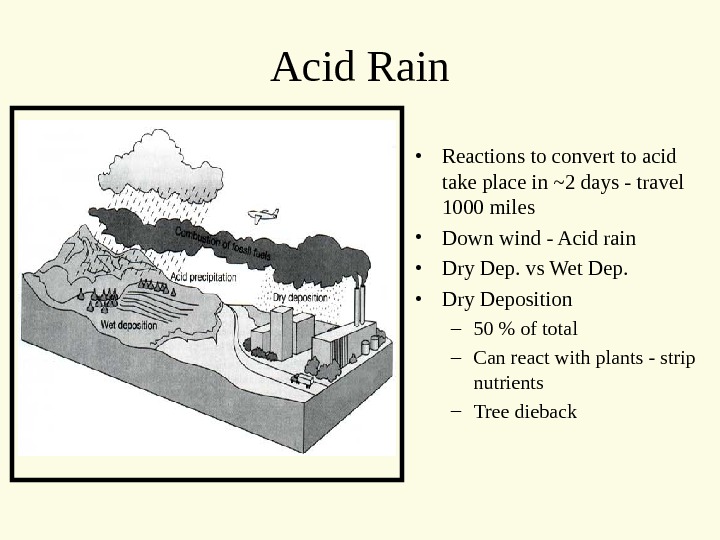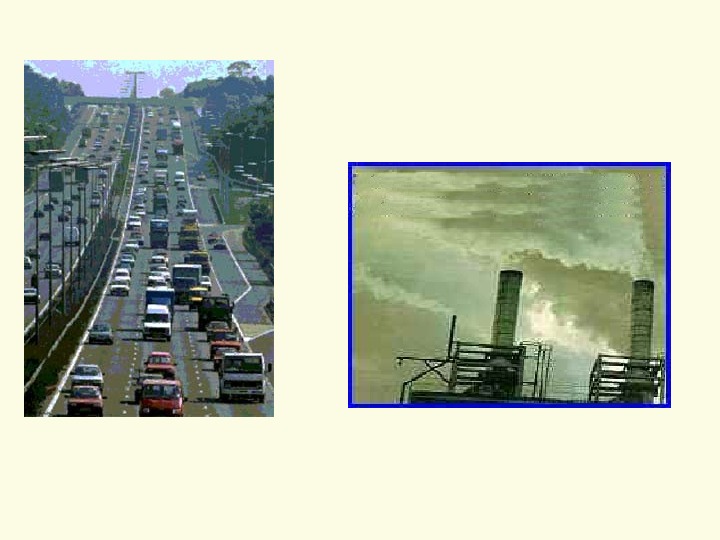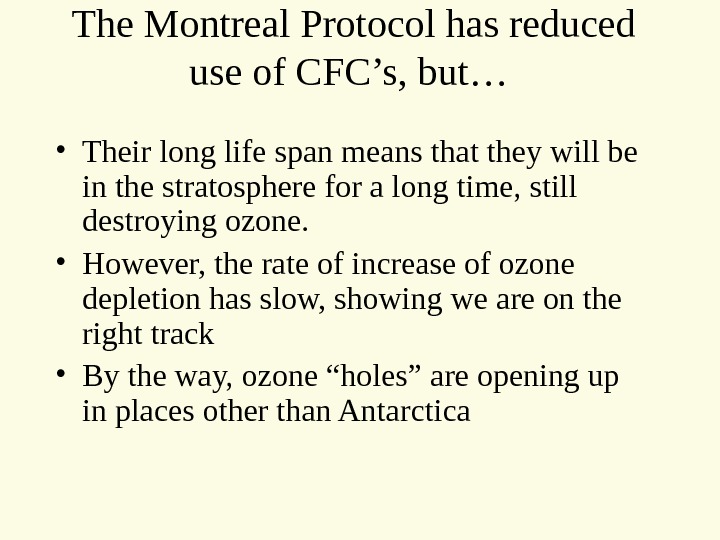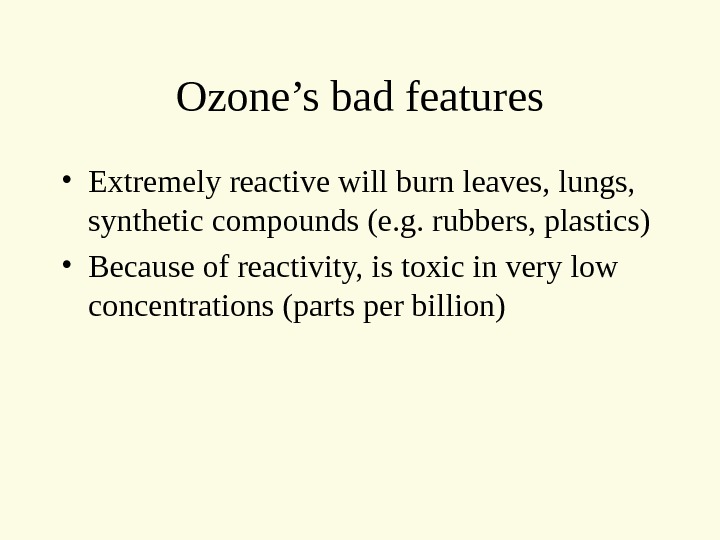Презентация asid rainswater pollution Боднара



























































- Размер: 2.5 Mегабайта
- Количество слайдов: 58
Описание презентации Презентация asid rainswater pollution Боднара по слайдам
 Today — Quiz — Earth Day — Nutrients as Pollutants — More Atmospheric Pollutants — Begin Water Pollution — In-class Debate Prep
Today — Quiz — Earth Day — Nutrients as Pollutants — More Atmospheric Pollutants — Begin Water Pollution — In-class Debate Prep
 http: //www. earthday. gov/Today is Earth Day, April 22 nd
http: //www. earthday. gov/Today is Earth Day, April 22 nd
 • It isn’t the pollution that’s harming the environment. It’s the impurities in our air and water that are doing it. – Dan Quayle. Our Society needs a better understanding of how we get clean water for all human needs
• It isn’t the pollution that’s harming the environment. It’s the impurities in our air and water that are doing it. – Dan Quayle. Our Society needs a better understanding of how we get clean water for all human needs
 ENERGY STAR — Energy-efficient choices can save families about a third on their energy bill with similar savings of greenhouse gas emissions, without sacrificing features, style or comfort. ENERGY STAR is a government-backed program helping businesses and individuals protect the environment and make the energy-efficient choice. Global Warming Actions In the Home — This page contains information about how individuals can cut their utility bills by purchasing energy-efficient appliances, fixtures, and other home equipment and products while reducing the risk of global warming. Manage Your Household’s Water Pollution — Although individual homes may contribute only minor amounts of water pollution, the combined effect of an entire neighborhood can be serious. What can you do?
ENERGY STAR — Energy-efficient choices can save families about a third on their energy bill with similar savings of greenhouse gas emissions, without sacrificing features, style or comfort. ENERGY STAR is a government-backed program helping businesses and individuals protect the environment and make the energy-efficient choice. Global Warming Actions In the Home — This page contains information about how individuals can cut their utility bills by purchasing energy-efficient appliances, fixtures, and other home equipment and products while reducing the risk of global warming. Manage Your Household’s Water Pollution — Although individual homes may contribute only minor amounts of water pollution, the combined effect of an entire neighborhood can be serious. What can you do?
 Learn to Conserve Water in Your Home — You can also take a virtual tour that will show you how to save water in nearly every room in your house at the California Urban Water Conservation Council’s Web site H 2 OUSE Maintain Your Septic System — One in four American homes is served by septic systems. The U. S. Bureau of the Census reported that at least 10% of septic systems failed in the previous year. Help Prevent Stormwater Runoff — Pollution from stormwater runoff is the most common cause of water pollution today. Help Prevent Pollution in Your Community — Learn about a variety of steps you can take. What can you do?
Learn to Conserve Water in Your Home — You can also take a virtual tour that will show you how to save water in nearly every room in your house at the California Urban Water Conservation Council’s Web site H 2 OUSE Maintain Your Septic System — One in four American homes is served by septic systems. The U. S. Bureau of the Census reported that at least 10% of septic systems failed in the previous year. Help Prevent Stormwater Runoff — Pollution from stormwater runoff is the most common cause of water pollution today. Help Prevent Pollution in Your Community — Learn about a variety of steps you can take. What can you do?
 Ecosystems • an assemblage of different species and their physical environment , all organized in a way that each population of organisms obtains energy and nutrients through specific pathways within the ecosystem.
Ecosystems • an assemblage of different species and their physical environment , all organized in a way that each population of organisms obtains energy and nutrients through specific pathways within the ecosystem.
 Acid Rain • Reactions to convert to acid take place in ~2 days — travel 1000 miles • Down wind — Acid rain • Dry Dep. vs Wet Dep. • Dry Deposition – 50 % of total – Can react with plants — strip nutrients – Tree dieback
Acid Rain • Reactions to convert to acid take place in ~2 days — travel 1000 miles • Down wind — Acid rain • Dry Dep. vs Wet Dep. • Dry Deposition – 50 % of total – Can react with plants — strip nutrients – Tree dieback

 Acid Rain and Trees
Acid Rain and Trees
 Forests affected by Acid Rain Northeast US Canada Northern Europe Asia
Forests affected by Acid Rain Northeast US Canada Northern Europe Asia
 Acid Rain and Buildings Many buildings are made of concrete and or stone These compounds act as bases and react with acid The building technically “weathers” very fast, or Non technically “crumbles”
Acid Rain and Buildings Many buildings are made of concrete and or stone These compounds act as bases and react with acid The building technically “weathers” very fast, or Non technically “crumbles”
 Europe The US Capitol
Europe The US Capitol
 Human Emissions — Combustion • NOx • N 2 +O 2 —> 2 NO • Forms in high temperatures of combustion engine • Converted in the atmosphere to HNO 3 — nitric acid Fromatm.
Human Emissions — Combustion • NOx • N 2 +O 2 —> 2 NO • Forms in high temperatures of combustion engine • Converted in the atmosphere to HNO 3 — nitric acid Fromatm.
 Human Emissions — Fertilizer • N 2 +Energy H+ —> NH 3 • Formed by the Haber process • Added to fields all over the world, but often lost after harvest
Human Emissions — Fertilizer • N 2 +Energy H+ —> NH 3 • Formed by the Haber process • Added to fields all over the world, but often lost after harvest
 Acid Neutralization • How does this work? • Cation Exchange on clay minerals • Role of chemical weathering. . .
Acid Neutralization • How does this work? • Cation Exchange on clay minerals • Role of chemical weathering. . .
 Where do N emissions originate? ~ 55% come from agriculture ~ 25% come from industry – e. g. coal fired power plants ~ 20% come from automobiles
Where do N emissions originate? ~ 55% come from agriculture ~ 25% come from industry – e. g. coal fired power plants ~ 20% come from automobiles
 Major powerplants – sources of N emissions – Acid rain
Major powerplants – sources of N emissions – Acid rain
 Nitrogen deposition 1989 — 1991 Nitrogen deposition 1995 —
Nitrogen deposition 1989 — 1991 Nitrogen deposition 1995 —
 Change in NOx emissions 1990 —
Change in NOx emissions 1990 —
 Surface water sensitivity to Acid Deposition — known in
Surface water sensitivity to Acid Deposition — known in
 Surface water sensitivity to Acid Deposition — known in
Surface water sensitivity to Acid Deposition — known in
 1990 5, 700 1998 11, 600 Emissions increasing in the western US
1990 5, 700 1998 11, 600 Emissions increasing in the western US
 1990 15, 800 1998 17, 600 Emissions increasing in the western US
1990 15, 800 1998 17, 600 Emissions increasing in the western US
 1990 24, 700 1998 28, 800 Emissions increasing in the western US
1990 24, 700 1998 28, 800 Emissions increasing in the western US
 Recent and current policies to reduce acid precipitation and Nitrogen emissions are shifting the problem from one area to another While emissions are remaining stable or decreasing in already Heavily impacted areas, they are increasing in formerly “ clean” or relatively unimpacted areas (including other countries!) — Nitrogen is only one compound important in acid rain and pollutant emissions to the atmosphere sulfur – SOx – has been a relative success story mercury is not an acid forming element, but is extremely toxic and is still increasing Acid Rain Summary
Recent and current policies to reduce acid precipitation and Nitrogen emissions are shifting the problem from one area to another While emissions are remaining stable or decreasing in already Heavily impacted areas, they are increasing in formerly “ clean” or relatively unimpacted areas (including other countries!) — Nitrogen is only one compound important in acid rain and pollutant emissions to the atmosphere sulfur – SOx – has been a relative success story mercury is not an acid forming element, but is extremely toxic and is still increasing Acid Rain Summary
 Other types of air pollution • The difference between stratospheric and tropospheric ozone • Photochemical smog – Inversion layers
Other types of air pollution • The difference between stratospheric and tropospheric ozone • Photochemical smog – Inversion layers
 Where is ozone the “good guy”? trophospherestratosphere
Where is ozone the “good guy”? trophospherestratosphere
 In the stratosphere…. • Ozone blocks incoming Ultra-violet radiation • Ultraviolet radiation – Skin cancer – Cataracts – Plant Damage
In the stratosphere…. • Ozone blocks incoming Ultra-violet radiation • Ultraviolet radiation – Skin cancer – Cataracts – Plant Damage
 But, what’s happening to ozone in the Stratosphere? 1979 -1985 1986 -1992 Deeper purple color means Less ozone above Antartica
But, what’s happening to ozone in the Stratosphere? 1979 -1985 1986 -1992 Deeper purple color means Less ozone above Antartica
 Why? • Chlorofluorocarbons (CFC) are very stable compounds that we produce at earth’s surface • They migrate to the stratosphere • Their chlorine gets excited by ultraviolet light • After excitation, chlorine attacks ozone layer, depleting it.
Why? • Chlorofluorocarbons (CFC) are very stable compounds that we produce at earth’s surface • They migrate to the stratosphere • Their chlorine gets excited by ultraviolet light • After excitation, chlorine attacks ozone layer, depleting it.
 The Montreal Protocol has reduced use of CFC’s, but… • Their long life span means that they will be in the stratosphere for a long time, still destroying ozone. • However, the rate of increase of ozone depletion has slow, showing we are on the right track • By the way, ozone “holes” are opening up in places other than Antarctica
The Montreal Protocol has reduced use of CFC’s, but… • Their long life span means that they will be in the stratosphere for a long time, still destroying ozone. • However, the rate of increase of ozone depletion has slow, showing we are on the right track • By the way, ozone “holes” are opening up in places other than Antarctica
 Where is ozone the “bad guy”? trophospherestratosphere
Where is ozone the “bad guy”? trophospherestratosphere
 Photochemical Smog VOCs break Cycle, allowing PAN to form from NO +VOC PAN = Peroxyacetyl nitrate
Photochemical Smog VOCs break Cycle, allowing PAN to form from NO +VOC PAN = Peroxyacetyl nitrate
 Examples of Smog
Examples of Smog
 NO x + VOC Ozone + Pan light reactants products. Chemical Equation for Photochemical Smog PAN = Peroxyacetyl nitrate
NO x + VOC Ozone + Pan light reactants products. Chemical Equation for Photochemical Smog PAN = Peroxyacetyl nitrate
 Where reactants come from • NOx primarily from transportation • VOC from a variety of sources, including refining, other industries, etc.
Where reactants come from • NOx primarily from transportation • VOC from a variety of sources, including refining, other industries, etc.
 Inversion layers trap cold air, allowing pollutants to build up in concentrations, including the compounds needed for photochemical smog Cold air Warm air
Inversion layers trap cold air, allowing pollutants to build up in concentrations, including the compounds needed for photochemical smog Cold air Warm air
 Ozone’s bad features • Extremely reactive will burn leaves, lungs, synthetic compounds (e. g. rubbers, plastics) • Because of reactivity, is toxic in very low concentrations (parts per billion)
Ozone’s bad features • Extremely reactive will burn leaves, lungs, synthetic compounds (e. g. rubbers, plastics) • Because of reactivity, is toxic in very low concentrations (parts per billion)
 Humans depend on very small reservoirs of water for all our needs These reservoirs cycle/ turnover very quickly As they cycle they can either collect pollution from other sources, or be cleaned by passing through functioning ecosystems Water Pollution
Humans depend on very small reservoirs of water for all our needs These reservoirs cycle/ turnover very quickly As they cycle they can either collect pollution from other sources, or be cleaned by passing through functioning ecosystems Water Pollution
 Water Pollution
Water Pollution
 Water Pollution
Water Pollution
 Water Pollution Two major classifications • Point Source • Non-point Source
Water Pollution Two major classifications • Point Source • Non-point Source
 Point Sources • Single large source • Can localize it to one spot – Industrial Plants — Sewage pipes
Point Sources • Single large source • Can localize it to one spot – Industrial Plants — Sewage pipes
 Point Source — Example • LUST — Leaky Underground Storage Tanks • 22% of the 1. 2 million UST are LUSTy • Look at water pollution from gasoline. . .
Point Source — Example • LUST — Leaky Underground Storage Tanks • 22% of the 1. 2 million UST are LUSTy • Look at water pollution from gasoline. . .
 Point source examples
Point source examples
 • Non-point Sources • Diffuse source or many smaller point sources • Automobiles • Fertilizer on fields
• Non-point Sources • Diffuse source or many smaller point sources • Automobiles • Fertilizer on fields
 Non point source examples
Non point source examples
 Non-point source pollutants — nutrients
Non-point source pollutants — nutrients
 End Lecture 4/22/
End Lecture 4/22/
 In class activity – pollutant sources in the Chesapeake Bay
In class activity – pollutant sources in the Chesapeake Bay
 The four main roles for class debate on 5/1/2003 Pacific Lumber Company /Maxxam Corporation The CEO’s The managing directors of the project Environmentalists Sierra Club Members Earth. First! Activists Townspeople Local loggers Local sports persons Government Representatives Bureau of Land Management California Representative who introduced the legislation
The four main roles for class debate on 5/1/2003 Pacific Lumber Company /Maxxam Corporation The CEO’s The managing directors of the project Environmentalists Sierra Club Members Earth. First! Activists Townspeople Local loggers Local sports persons Government Representatives Bureau of Land Management California Representative who introduced the legislation

 How does acid kill the fish? One way is mobilizing metals • When all base cations are striped from soils • Acid now reacts with metals e. g. aluminum – Normally aluminum is immobile – below p. H 5 — mobile aluminum • Fish breath in the water – Aluminum comes out of solution – Clogs gills — suffocate
How does acid kill the fish? One way is mobilizing metals • When all base cations are striped from soils • Acid now reacts with metals e. g. aluminum – Normally aluminum is immobile – below p. H 5 — mobile aluminum • Fish breath in the water – Aluminum comes out of solution – Clogs gills — suffocate
 When the p. H drops below 6. 0 species start to die off. When one species dies, others that depend on it may as well Acid Rain Effects – Aquatic Systems
When the p. H drops below 6. 0 species start to die off. When one species dies, others that depend on it may as well Acid Rain Effects – Aquatic Systems
 Watersheds – Large areas thought to be nitrogen saturated
Watersheds – Large areas thought to be nitrogen saturated
 Land — Sensitive Ecosystems to Nitrogen Deposition
Land — Sensitive Ecosystems to Nitrogen Deposition
 Acid Rain Summary
Acid Rain Summary
 We’re not the only ones concerned about photochemical smog
We’re not the only ones concerned about photochemical smog

